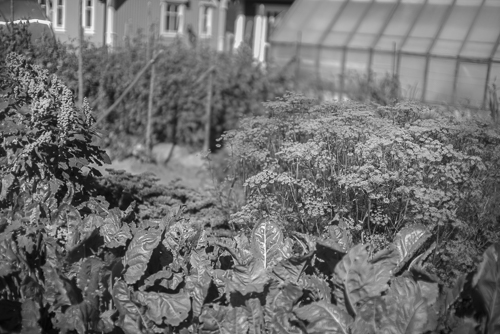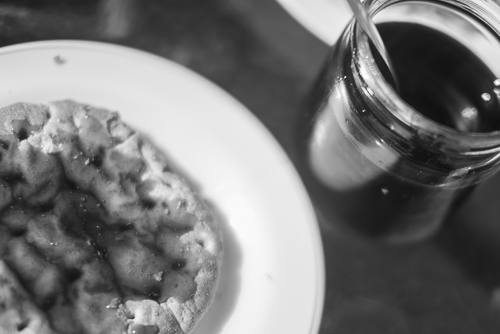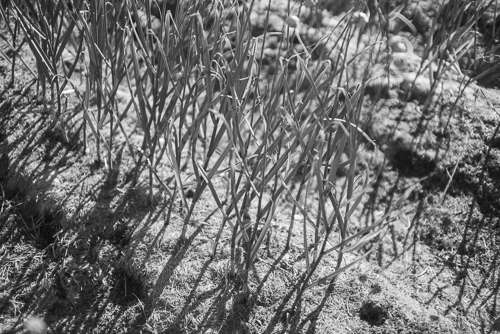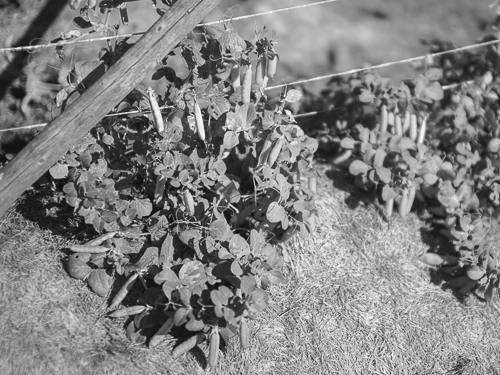 A detail of the preparedness garden with a small greenhouse
A detail of the preparedness garden with a small greenhouse
I’ve known about the Dacha preparedness garden for several years, but because of Covid-19, I deferred contacting them until times were more tranquil. Then, we agreed to meet in August since the garden would be in full bloom at this time of year.
The word dacha is derived from Russian, meaning a seasonal or year-round second home, often located in the exurbs of Russian-speaking and other post-Soviet countries
The garden is driven by Anders and Barbro Nordrum and it is next to their house on the west side of the Strond fjord next to the town of Fagernes.
I was met by Anders and he let me know about his origins, his thoughts about the preparedness garden and preparedness in general. Eating a light meal together, consisting of amongst others of bread with home-made syrup made from beetroot, Anders told me that he and his wife had made the syrup themselves.
 A glass with homemade syrup and a slice of bread with syrup
A glass with homemade syrup and a slice of bread with syrup
It was a time-consuming process, but at least it had showed that they didn’t need to buy sugar. In addition, although sugar is cheap and in plentiful supply now, it may not last.
During our meal, he talked about his father who was responsible for radio communication during catastrophes in very poor countries.
It’s naive to think that even though we are rich and live in Norway that we will always manage by buying what we need from other countries.
He has always had a small plot of land where he has been growing vegetables and he has worked as a gardener and horticulture teacher at a gardening school for many years. Now, he’s working with horticulture in a prison in Valdres.
We are particularly vulnerable to lack of artificial fertilisers, concentrated feeds, agricultural machinery, electrical power and fuel.
During the First World War, Norway was ill prepared for the blockade of imported food, which took place. Thus, in order to be better prepared next time, Norway had a depot of grain from 1928 to 1995 and it should cover one year’s national consumption of grain. From 1996, it was gradually reduced and closed down in 2003.
When Norway was invaded by Germany in 1940, the grain depot lasted till some time in 1941. In addition, there were many more farms than nowadays, farmers still had work horses and lots of people worked at the farms.
To help people survive, the state made a brochure, which was called Mother Norway’s food book (Mor Norges matbok) and sent it to all households in Norway in 1940. It can be viewed here.
Horticulture teacher Sverre Østlie published a book called ‘Cultivating potatoes and vegetables for amateurs‘ in 1942.
Food preparedness was not mentioned in the election campaign in the autumn of 2020. The government of Mrs Solberg is satisfied because they have stress tested the supply lines, and now they are relaxing.
What happens in case of another pandemic, drought, a huge sun storm, etc.?
The garden
Being sort of grown up with preparedness, Anders wants to have a plan B if the borders are closed and supplies run out. Anyway, in such cases he plans to stay on his property and cooperate with other people to help them with getting food too.
A preparedness garden uses areas which, in any case, are not suitable for farmers and it doesn’t require resources which may be lacking in a crisis like machines, fuel, electrical power, etc.
Initially, they used manure and artificial fertiliser to give nutrition to the vegetables, but they didn’t grow well. Meanwhile, their daughter Maria had studied Russian in Russa and even lived there for 5 years. At Easter in 2011, they went to visit her and her friends. On the tenth floor of a block of flats in Archangel, they could see shelves with fertilised vegetables, berries turned into jam and potatoes in sacks, all from their own dacha.
They visited Vitalij and Jekaterina in the village of Brin-Navolok in the vicinity of Archangel in 2015. They had a dacha where they were growing vegetables and potatoes without manure because they had stopped raising domestic animals due to old age. Instead, they covered the ground of their fields with compost and grass they had mown themselves.
After having returned from visiting the dacha of Vitalij and Jekaterina in Russia, they stopped applying both manure and artificial fertilisers and started instead to cover the ground with compost and grass, which they got from a nearby football field.
 Onion plants in the preparedness garden
Onion plants in the preparedness garden
The grass cover amended the soil by keeping the soil humid and warm and reducing weeds. Just after a few weeks, it had another structure with more earthworms, which pull the grass down into the soil and leave behind nutritious waste. In fact, there were so many earthworms that birds started picking the soil to catch them, but Anders has covered the ground with insect nets to prevent the birds from taking earthworms.
They also apply urine, diluted with water in the ratio 1:10, and an infusion from nettles, which have been infused in water for some weeks, to fertilise the vegetables during sowing and planting. Both liquids contain nitrogen and lots of minerals that are beneficial to the vegetables.
Soil needs to protect itself against erosion, and there is no black ground in nature for a long time because it will be healed by letting weeds grow there.
Maria has written a book in Norwegian about preparedness gardens with her parents as helpers.
It’s common to tend the flowers, but the book instead tells us that it’s the soil we should tend.
Barren and compact soil can be amended and everything required is available in nature.
Good soil is made by dead organic material falling to the surface of the soil and earthworms pull it into the soil. However, we have to give the earthworms a helping hand in the beginning by laying organic material like branches, potato peel, leftovers and seaweed at least 20 cm below ground. Instead, grass and wizened leaves can be laid on the ground, while compost and manure can be worked into the upper layer of the soil. Biochar can be used both on top of and in the soil, while ash can be put on the ground.
In order to have a plan B for the lawn to turn it into a preparedness garden, it is necessary to have the following: spade, pitchfork, scythe, wheelbarrow, insect net, non-woven fabric to protect the plants against frost in cold countries and last, but not least seeds.
The distance from where one lives should be limited to what can be carried by a wheelbarrow. The area of the garden should be at least 2 square metres, while the preparedness garden has an area of 200 square metres. 15-20 types of vegetables are recommended, and greater diversity gives more resilience against changing weather and insects.
Crop rotation is highly recommended to reduce plant diseases.
Anders has used hügelkultur to make beds in the preparedness garden. First, he removed some of the topsoil, next he put rotten branches where the topsoil had been, finally he covered all of it with topsoil. Hügelkultur leads to less plant diseases, it keeps the heat of the soil to some degree and it improves drainage.
While Anders and Barbro were in Russia, they got two bulbs of garlic from a Russian monk. After having brought them back to Norway, the bulbs have given rise to about 15,000 garlic all over Norway to upwards of 1000 m above sea level.
They are also growing an ancient sort of wheat, which was brought from the highlands of Mexico, where there is a short growing season. Now, other growers in Norway have also started cultivating it in the highlands of Norway.
They are growing kohlrabi together with rocket or arugula . This is a good way of lessening the impact of attacks from caterpillars of the butterfly species white or garden white.
Anders and Barbro are also broadcasting how to do a preparedness garden on their web site. The web site is chock full of advice on making a preparedness garden, growing vegetables, keeping seeds and much more.
Seeds A package of 20 seeds, consisting of cucumber, cauliflower, broad bean, broccoli, dill, kale, carrot, Savoy cabbage, kohlrabi, parsley, rutabaga, turnip, leek, radish, beetroot, lettuce, squash, pea, a rye called svedjerug in Norwegian or slash and burn rye, and tomato is sold at beredskapshagen.
The Norwegian company Solhatt offers about 40 types of seed for sale, all of which have been grown in Norway.
The Svalbard global seed vault contains seeds from all over the world and its purpose is to ensure genetic diversity of seeds. The amount of each type of seed is too low to be used in a time of crises.
KVANN is a Norwegian NGO where the members take care of and grow seeds.
Norgro sells a variety of seeds.
Two sorts of peas
There are many vegetables in the garden and two of them are a sort of peas called ‘Jærert’ and ‘Lomsert’ in Norwegian, both of them named after where they have been cultivated: one at Jæren and the other one at Lom.
The first one was grown for many years in fields of oats, and it was a hardy and easily cultivated sort and adapted the soil and climate at Jæren. From the 1950s onward, agriculture was gradually mechanized and the pea began falling out of use. Fortunately, it was saved by the efforts of only one man, the former chief county agricultural officer Einar K. Time.
It is worth noting that ‘Jærert’ has been included in the Ark of Taste.
 Pea plants in the preparedness garden
Pea plants in the preparedness garden
‘Lomsert’ is another old type of pea, which has been grown locally in Lom in the Gudbrand valley.
While ‘Jærert’ can grow to be 2-3 m tall, ‘Lomsert’ attains a height of tens of centimetres above ground.
Farewell
Being very hospitable and kind, Anders and Barbro gave me some leaves of kale and lots of pods of peas. As if that wasn’t enough, they also gave me a signed copy of the book which their daughter Maria has written with their help.
Let’s hope that they can keep the preparedness garden going and open for visitors for many more years to come.
The web site
Note that the web site of the preparedness garden is at https://www.datsja.no/.
